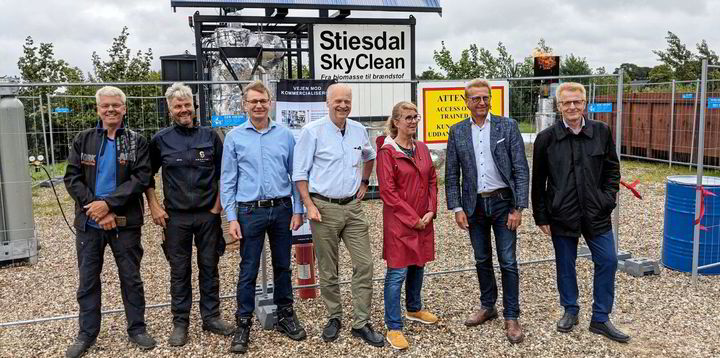
A prototype of a innovative plant that will produce green fuel using an oxygenless pyrolysis oven to avoid generating CO2 has been launched by clean energy pioneer Henrik Stiesdal’s outfit Stiesdal Fuel Technologies (SFT).
Built by SmedTek, a small farm machine shop in rural Denmark, the 200kW SkyClean plant, which will treat 500 tons of agricultural waste a year for a CO2 reduction of some 600 tons, is seen as a key step in development of 2MW facility being set up at Greenlab in Skive later this year.
“The plant is an important stepping-stone for us in the development of the processes in SkyClean, and it has been a pleasure to see SmedTek build what is for them a completely new type of industrial plant in a very short time,” said Stiesdal.
“The UN's new climate report emphasises that speed matters. We know that SkyClean can provide both CO2 reduction and jobs, and we know that it is urgent to get this type of climate solution on track if we are to avert the worst effects of global warming in time.”
The SkyClean plant at GreenLab, expected to cost around DKr20m ($3m), will move the technology toward commercialisation in 2022, when another 2MW pilot plant – being built with Haldor Topsøe, Arla Foods, Orsted and the Danish Technical University (DTU) – will be established “with a view to further developing processes and further optimisation for commercial production”, said Stiesdal.
SFT foresees construction of the 10-20MW SkyClean plant in the autumn of 2022.
Experts from the DTU and Aarhus University have calculated that the agriculture industry can halve its greenhouse gas emissions using the SkyClean technology.
As Recharge has previously reported, the end product of Stiesdal’s SkyClean process will be a fuel that is chemically identical to the A-1 jet fuel currently used by airlines but produced in a process that actually removes carbon from the atmosphere. This means the more SkyClean fuel is burned, the more CO2 is removed from the air.
Other green aviation fuels being developed — biofuels and synthetic “e-fuels” made from green hydrogen combined with captured CO2 — are merely carbon-neutral, neither adding to nor reducing overall CO2 levels.
SkyClean, however, is based on a pyrolysis process that uses agricultural waste as feedstock and delivers both fuel and biochar.
In simple terms, a pyrolysis oven is used to heat agricultural waste in the absence of oxygen, converting the biomass into three components: biooil, syngas and biochar. The biooil and syngas are then combined with green hydrogen – produced by using renewable energy to split water molecules into hydrogen and oxygen – to create biomethanol, which is then synthesised into aviation fuel.
Around half of the carbon content of the agricultural waste is not converted into biooil and syngas but is delivered as biochar, a carbon-based solid similar to charcoal. Biochar does not decompose or rot when spread on the ground; it is stable in nature for millennia. Since the plants that comprise the feedstock for the SkyClean process took all their carbon content from the atmosphere in the form of CO2, and since about half of the carbon is sequestered as biochar — leaving only half to become converted into fuel — the process is carbon negative.
"fuel" - Google News
August 18, 2021 at 11:43PM
https://ift.tt/3z1zZFI
Clean energy pioneer Stiesdal starts up 'stepping stone' CO2-negative green fuel plant | Recharge - Recharge
"fuel" - Google News
https://ift.tt/2WjmVcZ
Bagikan Berita Ini















0 Response to "Clean energy pioneer Stiesdal starts up 'stepping stone' CO2-negative green fuel plant | Recharge - Recharge"
Post a Comment